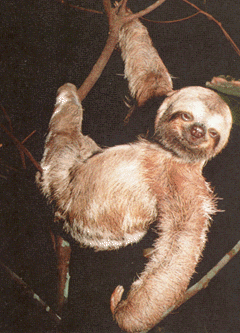This family includes 3 Recent species in one genus, Bradypus. It is distributed through Central and South America, south to southern Brazil.
Bradypodidae
three toed sloths
Three-toed sloths weigh 3 - 5 kg; their bodies run around 0.5 m in length. They are covered with dense, long, shaggy fur made up of thick hairs with longitudinal grooves. Beneath the overfur is short underfur of finer texture. Some have unusually long neck hairs, which form a mane. Individual hairs are directed so that they point towards the ground when the animal hangs beneath a branch, perhaps helping it shed rain. Three-toed sloths are mostly tan or yellow-brown in color (with some contrasting markings on the face and mane), and the grooves in the individual hairs contain algal cells that give the coat a greenish cast. Bradypodids have a short and very stout tail.
The forearms of three-toed sloths are longer than the hind limbs. Fore and hind feet have three enlarged, hook-like claws. The claws are separate, but the digits to which they attach are syndactylous. Three-toed sloths have a short, rounded skull. The profile is somewhat flattened dorsoventrally. The zygomatic arch is incomplete. A large jugal is present, and at its termination it forks broadly into dorsal and ventral processes. A tympanic bulla is present. The mandible has a well developed coronoid process, and the condyloid process is elevated above the level of the toothrow.
The teeth of three-toed sloths are highly distinctive. Incisors and canines are lacking and the number of cheek teeth is reduced to 5/4-5 = 18-20. Each tooth is a simple, ever-growing peg surrounded by a thin layer of dentine (but no enamel) and coated with cementum. The anteriormost teeth are smaller than the more posterior ones, and the anterior upper teeth do not occlude with the anterior lower teeth.
Members of this family have 9 cervical vertebrae, 2 more than the number found in almost all other mammals. Three-toed sloths are solitary and arboreal. They rarely descend from the trees, coming to ground once every 8 days to defecate, and occasionally to cross open ground. They are strong swimmers. Their movements in the trees and on the ground are very slow and deliberate, but they are capable of slashing rapidly with their claws in defense against predators. It has been suggested that their slow and deliberate style of moving is a defense against visually-orienting hawks and eagles. They are also preyed upon by mammalian predators such as cats, and by snakes such as boas and anacondas.
The diet of these species consists almost entirely of leaves. Their senses of sight and hearing are poorly developed, and they probably forage almost entirely using their senses of smell and touch. Their body temperature and metabolic rate are unusually low, and they thermoregulate partly by sunning.
No fossils of bradypodids are known.
HOME
HerbWeb
Sloth hotlinks
Two-toed sloths
The Animal Rights FAQ01 : 02 : 03 : 04 : 05 : 06 : 07 : 08 : 09 : 10 : 11 : 12 : 13 : 14 : 15 : 16
S L O T H S . O R G
T H E C O U N T D O W N H A S B E G U N
